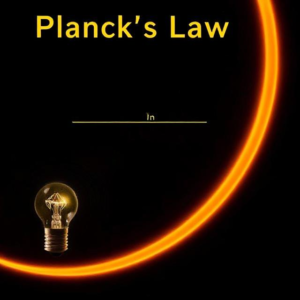Blackbody Radiation and Radiation Pressure: Explained
A blackbody is an ideal object that absorbs all the light or radiation that hits it, without reflecting any. It also emits radiation in a way that depends only on its temperature, not on its material or other properties. In real life, there’s no perfect blackbody, but a black-painted surface or a hole in a container can behave similarly to a blackbody.

Key Points:
- Absorbs All Radiation: A blackbody absorbs all incoming light or radiation. It doesn’t reflect or transmit any light.
- Emits Radiation: A blackbody also emits radiation (gives off light and heat) based on its temperature. The hotter the object, the more radiation it emits. For example, a red-hot metal is emitting radiation, but the same metal at room temperature would emit far less.
Planck’s Law and Blackbody Radiation:
- The intensity (brightness) of the radiation emitted by a blackbody depends on its temperature.
- As the temperature of a blackbody increases:
- It emits more radiation overall.
- The peak of the radiation shifts to shorter wavelengths (from red to blue light as it gets hotter).
For example:
- A cold object (like a piece of ice) emits mostly infrared radiation (heat you can’t see).
- A hot object (like the Sun) emits mostly visible light, and its color changes from red (cooler) to blue (hotter).
Stefan-Boltzmann Law:
- This law tells us how much energy a blackbody emits at a given temperature:
- E is the total energy emitted.
- σ is the Stefan-Boltzmann constant.
- T is the temperature in Kelvin.
- The equation shows that as the temperature of the object increases, the energy it emits increases dramatically (it’s to the power of 4).
Real-Life Example:
Think about a lightbulb:
- When the filament inside the lightbulb gets hot, it glows. If it were a perfect blackbody, it would emit infrared radiation (heat) and visible light depending on its temperature.
- A blackbody at high temperatures like the Sun emits mostly visible light and ultraviolet radiation, which we can see and feel as warmth.
Radiation Pressure:
Now, radiation pressure is the pressure exerted by light or any form of electromagnetic radiation (like visible light, infrared, or ultraviolet) on an object. This pressure happens because light carries energy, and when it hits an object, it transfers some of that energy to the object, creating a tiny force.
How Does Radiation Pressure Work?
- Light Carries Energy: All forms of light (electromagnetic radiation) carry energy. When this light hits an object, the energy gets transferred to the object.
- Transfer of Energy = Force: When the radiation hits the surface of the object, the energy is transferred. If the radiation is absorbed, it gives the object a small push. If it is reflected, the push is slightly stronger because the energy is reflected rather than just absorbed.
Formula for Radiation Pressure:
The radiation pressure
on an object is related to the intensity
of the radiation and the speed of light
:
- I is the intensity (energy per unit area per second) of the radiation.
- c is the speed of light (approximately 300,000 km/s).
So, radiation pressure depends on how much energy the radiation carries and how fast it is moving. The more intense the light and the smaller the object, the greater the radiation pressure.
Example in Space:
In space, the Sun’s radiation exerts a very small but continuous pressure on objects (like satellites or space dust). This pressure, though tiny, can influence the motion of objects in space, especially when there’s no other force acting on them (like gravity or air resistance).
Solar Sails:
One of the cool uses of radiation pressure is solar sails used in space travel. These sails are designed to catch the Sun’s radiation and use the small force from radiation pressure to push spacecraft forward. It’s a very small force, but in space, where there is no friction, it can cause the spacecraft to gradually accelerate.
Key Differences:
- Blackbody Radiation: Refers to the radiation (light and heat) emitted by a body depending on its temperature. A blackbody absorbs and emits radiation at specific wavelengths.
- Radiation Pressure: Refers to the small force exerted on an object by radiation (light) when it hits the object, transferring energy.
Summary:
- Blackbody Radiation: A blackbody absorbs and emits all types of radiation based on its temperature. Hotter objects emit more radiation, and the type of radiation depends on the temperature (from infrared to visible light).
- Radiation Pressure: This is the force exerted on an object by light or electromagnetic radiation. Though small, it can push objects, and it’s used in technologies like solar sails in space.
In Simple Terms:
- Blackbody Radiation explains how hot objects glow and emit light and heat based on their temperature.
- Radiation Pressure is the tiny force light can exert on objects, and it’s powerful enough to push spacecraft in space.











